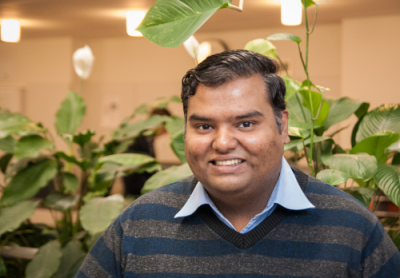Doctoral student Apramey Dube: How do customers experience service through apps?
I am Apramey Dube, doctoral candidate at the Centre for Relationship Marketing and Service Management (CERS). My research interests relate to customers’ service experiences and their implications for service managers. I am using smartphone apps as an empirical context where I conceptualize them as service platforms.
What are service experiences? We can answer this simply by saying; well, they are experiences of services. However, we have moved beyond this simplistic underst
anding of both the key words ‘service’ and ‘experience’. Service is no longer restricted to imply ‘services’ as business offerings (for e.g. a hair-cutting service), nor are they limited to after-sales support ‘services’ in the industrial setting. In the Nordic School of Service, where I am firmly rooted, service is a business perspective relating to customers’ value creation. In this perspective, service relates to all such activities and processes that aim for facilitating customer value creation. Therefore, when we use WhatsApp to communicate and create value (say by exchanging recipes with a friend) we derive service from the app platform.
Concurrently, the word experience has also undergone milestone shifts in its conceptualization. At the beginning of the 21st century, experts called the new global economy to be an ‘experience economy’ where customers do not buy products or services; rather they seek and buy experiences. Strikingly, there is a hidden assumption in this notion – which managers can package and deliver ‘experiences’ that customers will buy. My research specifically criticizes this fallacy – experiences are not delivered – instead they emerge in the customers’ world and are subjectively shaped by their individual contexts. Taking the above example, WhatsApp may be a platform for a good potential experience, however whether a recipe was successful and made the diners happy or not (aka value was created or not) is ultimately shaped by several other customer specific factors.
There are two striking insights that I have gained from my research. First, in addition to direct experiences, customers may also have indirect service experiences with smartphone apps (Dube and Helkkula, 2015). Such indirect experiences may happen without direct app use by customers. An illustration of an indirect experience is that of a jealous boyfriend, who perceives that his girlfriend devotes too much time (and affection!) to an app cat (virtual cat – Talking Tom app). This has led the boyfriend to experience a degradation in their relationship because the girlfriend is busy feeding, bathing and cuddling (all actions on the app) with the virtual app cat. The boyfriend doesn’t use the app, but is affected and has an indirect service experience (unfortunately not favorable) of the app.
The second insight throws light on the difference between managers’ expectations versus the actual lived experiences of customers (Dube et al., 2015). A hangover from the notion of ‘packaged experiences’ is that managers have pre-conceived expectations about the ways in which customers will experience service. For apps, these expectations can be often read as app use descriptions provided by app developers on app stores. In contrast, more often than not, the actual lived experience of customers differ from this understanding and may even surprise the service managers. Continuing the WhatsApp example, newspaper reports praised the innovative use of WhatsApp by a doctor in Mumbai India who conducted an emergency surgery by sending pictures and communicating through WhatsApp with other specialized doctors. The app is technically used as a communication tool, however its experience as a lifesaver for the doctor and the patient was unexpected by the developers.
A natural question arises at this point – are these insights only relevant for apps? I wish to point out here that although the empirical backdrop of my research has been smartphone apps, these findings find increasing resonance in service contexts of today and in future. Wearables are the next step in app evolution where apps now function as service platforms not only through a device in your hand (phone) but also through devices that are worn on different parts of the body (fitness trackers, shoe-sensors, smartwatches and others). In the industrial world, Internet of Things (IoT) represent increasingly sophisticated technologies where not only customers, but also devices may interact and derive ‘service’ from each other. In both these emerging technologies, apps and smarter service platforms are becoming ubiquitous, in turn enabling service provision in never before seen arenas. Therefore, indirect service experiences and difference between customers and service providers intended experiences would become more visible and play a bigger role in customers’ value creation.
Apramey's research publications can be found here Opens in new window .


